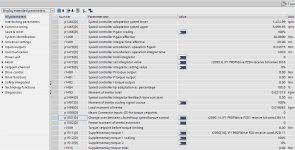JDCROCKETT724
Member
So here is my Siemens servo application. I am testing a part with two servos attached to it. One servo spins the part to different speeds while the other servo induces torque on the part. The torque needs to induce positive and negative torque depending on the test while on the fly.
I have a solution implemented that works, but I am wondering if I am over complicating it. My solution is to turn on torque limiting via the MC_TorqueLimiting block with the torque set to the test set point. Then to set the torque to either negative or positive I use a move velocity block with position controlled turned off to either drive the servo slower than the drive servo or faster than the drive servo. This creates a speed error that the drive attempts to correct by using torque that is limited.
The code works, but is there a better way? What would you do?
PLC is a 1500 and the servo drives are S120.
I am using telegrams 105 and 750.
I have a solution implemented that works, but I am wondering if I am over complicating it. My solution is to turn on torque limiting via the MC_TorqueLimiting block with the torque set to the test set point. Then to set the torque to either negative or positive I use a move velocity block with position controlled turned off to either drive the servo slower than the drive servo or faster than the drive servo. This creates a speed error that the drive attempts to correct by using torque that is limited.
The code works, but is there a better way? What would you do?
PLC is a 1500 and the servo drives are S120.
I am using telegrams 105 and 750.





